29 Games to Play for Sensory Movement Exploration at Home
Children who either seek out a lot of movement or are over-cautious about moving and being off ground will all benefit from having more movement opportunities in their daily routine.
The movement “seekers”, who climb, jump, dash and crash will need a lot of (safe) intensive and a variety of different types of movement opportunities to meet the needs of their sensory systems.
Children who seem to “avoid” or are anxious/ overwhelmed by movement will need slower, calmer, more controlled and repetitive movement activities to develop their tolerance and confidence.
As a parent, we will probably know which type of movement processing sensory system our child has. We need to remain mindful that their nervous system is still developing and over time it is possible that they will be able to satisfy their need for movement or tolerate more movement adventures as they mature.
As well as meeting sensory needs, moving the whole body improves our child’s strength, stamina, endurance, stability and mobility. It also challenges cognitive skills like motor planning, problem solving and bilateral integration (using the two sides of the body and brain together).
On this page, we share a number of ideas to help our children get moving at home. In some activities suggestions will be made for adapting to meet the needs of a movement “seeker” (S) or movement “avoider” (A).

Here are 29 fun activities you can try at home to burn some energy
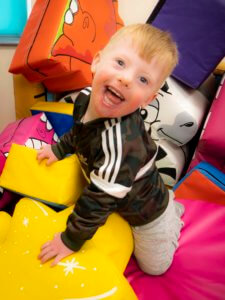 Obstacle course options are endless. You want to set it up to get your child to move in as many different ways as possible. (see this Our Home video for ideas of setting up a course)
Obstacle course options are endless. You want to set it up to get your child to move in as many different ways as possible. (see this Our Home video for ideas of setting up a course)Use furniture to make your course – setting it up with the help of your child is a lovely way to get them active as they will need to carry and move furniture and objects with you (S).
Let them come up with new obstacles as it will work their imaginations (S&A).
You could have themes on different days e.g.pirates, beach, jungle, castles
Once your obstacle course is set up, you can also add some extra stages and mark them with a piece of paper or some tape. For Seekers, add lots of variety and changes in direction. For Avoiders, add just one new action at a time, limiting changes of direction and head positions which can feel overwhelming. For example:
– Hopping on the spot
– Standing Long jumping (jump as far as possible with 2 feet or with 1 foot.)
– Spinning on the spot
– Once you have set this up you can ask them to negotiate the obstacles in different ways e.g.
– As a different animal
Like a fast car, like a bus stopping at each step.
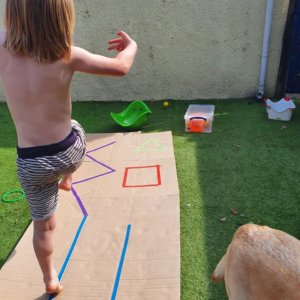 You can draw out an obstacle course with painters tape in a room or along your walls. This great video can give you some ideas of how to set up a tape obstacle course/ sensory path.
You can draw out an obstacle course with painters tape in a room or along your walls. This great video can give you some ideas of how to set up a tape obstacle course/ sensory path.Maybe put this along your corridor and your whole family can follow the steps each time they go through the corridor.
You can also do this along the pavement using chalk. See our video for ideas of what to do.
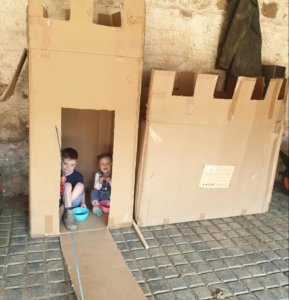 This has the added bonus of creating a space for them to play in after it is built. Provide your child with sheets and they can build a den anywhere in the house. The process of building it should mean lots of moving furniture and lifting cushions so is a great way to get them moving without realising it, especially for Seekers. Avoiders will benefit from building more slowly, over a longer period of time but their den will become a helpful calming place for them to “reset” and self-regulate when feeling overwhelmed.
This has the added bonus of creating a space for them to play in after it is built. Provide your child with sheets and they can build a den anywhere in the house. The process of building it should mean lots of moving furniture and lifting cushions so is a great way to get them moving without realising it, especially for Seekers. Avoiders will benefit from building more slowly, over a longer period of time but their den will become a helpful calming place for them to “reset” and self-regulate when feeling overwhelmed.
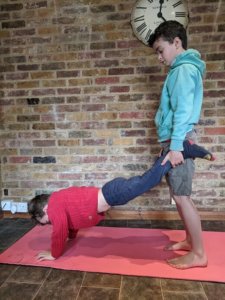 Wheelbarrow- hold your child by their hips with their legs straddling you and their hands on the floor. Move around the floor picking up objects for as far as you can go.
Wheelbarrow- hold your child by their hips with their legs straddling you and their hands on the floor. Move around the floor picking up objects for as far as you can go.Move your hands down to your child’s knees and walk around the room – picking up objects or playing a matching game or skittles (S)
If you can, hold your child by their ankles. Make sure they keep their bottom in the air and don’t hang their tummy down. Again find a game to make this more entertaining.
As your child gets stronger you could try to get from one end of the house to another – even trying going up the stairs.
You could also make an obstacle course to go around.
Seekers will love the physical challenge and strong input to their bodies. Avoiders will also benefit from this type of activity but keep it simple, in straight lines without too many additional games. If being upside down is challenging for them, start with “Crab Walking” with their hands and feet on the floor underneath them, tummy and face upwards.
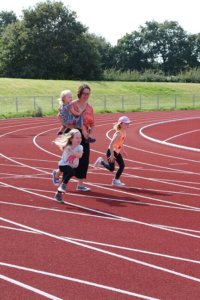 Use a combination of the sports day ideas above to make a great relay race around your home, each person taking their turn to complete a challenge.
Use a combination of the sports day ideas above to make a great relay race around your home, each person taking their turn to complete a challenge.
Avoiders may prefer to race against their own time, rather than other people.
Set up a balance board on a table or on the floor with a board and a bottle or rolling pin.
See this video for an explanation of how to play this great hand balance game.
Avoiders may prefer to balance on a soft cushion or rolled up blanket, so the tipping and change of direction is more subtle and slow.
You can use tape to make targets on the wall or floor. Painters tape works well as it doesn’t leave a mark when you remove it and is colourful.
You can also draw out an obstacle course with the tape in a room or along your walls.
This video gives lots of ideas of games to play with tape.
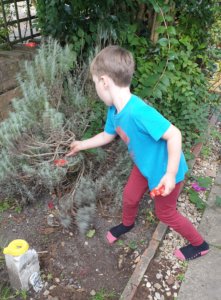 Take photos of objects around your home using either a tablet or just on your computer or phone.
Take photos of objects around your home using either a tablet or just on your computer or phone.Your child then needs to find each object around the house. See this ‘Our Home’ video as an example of the game in action.
You could also hide objects around the house for the child to find.
This is a great copy game. One person does an action and the other person has to copy them.
This is a great way to convince your child to do any action you want from them. Remember that Avoiders often struggle with rapid changes of head position. Helping them to tolerate this using slow controlled actions can be helpful and allow their sensory systems to adapt without feeling overwhelmed.
Alternatively ask them to lead the game and see where their imagination takes you.
This game can provide hours of fun. 1 person can hide around the home while the other counts out loud to 10 and then has to go around the home to find them.
Take turns in hiding and finding.
If your home isn’t very big, you could adapt this to hiding an object for them to find – e.g. a sock or stuffed animal.
You may want to start this game just in one room until they understand the game.
If you don’t have a parachute at home then a sheet will do the same job.
Hold onto the edges between at least 3 of you.
Put objects in the middle and make the objects move around the sheet by lifting or lowering your arms.
Challenge your children to try and work out how to make the object jump as high in the air as possible or go around in a circle as quickly as possible.
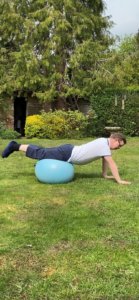 Use a gym ball for a fun way to challenge your child’s balance. A peanut-shaped ball is more stable than a round exercise ball- consider this for Avoiders. You might like to play the games below using Teddy or other toy before your child feels confident enough to try.
Use a gym ball for a fun way to challenge your child’s balance. A peanut-shaped ball is more stable than a round exercise ball- consider this for Avoiders. You might like to play the games below using Teddy or other toy before your child feels confident enough to try.When using a gym/physio ball, make sure you have complete control of the ball and your child to try this – it may take 2 adults. You can wedge the ball into the corner of the room to make it more stable until you are more confident in your handling.
Hold your child at their hips so you have control of their bottom and the ball. Very slowly move the ball in all directions, especially for Avoiders.
As they get more confident you can move in bigger movements but keep going very slowly to challenge them.
Hold the position at the extreme of where they can go to make it a little harder but have a second person ready to catch them if they fall.
See if they can balance themselves sat on the ball with feet on the floor. If they manage this, ask them to lift 1 leg to balance.
Ask them to lie back on the ball to pick up an object behind them and then make them sit up to give you the item. This might be very scary for an Avoider- it might make them startle or feel frightened, so do not suggest unless you feel confident that they are ready to try.
See Massage games with a ball for calm activities with an exercise ball.
Sitting on the exercise ball while watching TV or during table-top activities (if the heights work!) can be very helpful for movement Seekers. Some children can sustain their attention to a task for longer if they are able to generate their own movement when sitting.
Be careful if your child is impulsive and lacks a sense of danger as gym balls can be a recipe for disaster in the wrong hands!
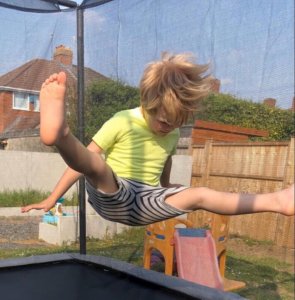 Jumping is a fabulous workout for children.
Jumping is a fabulous workout for children.Your child can jump on the bed, off the sofa onto a pile of cushions (use a fitted sheet to help make sure the cushions won’t slip away as they bounce onto them) or just on the floor.
Try giving them challenges – how many jumps can they do in a row. Can they throw and catch while they jump (this is harder than it sounds). Can they tuck their feet up as they jump and then land on their feet etc.
If you have a trampoline then these Trampoline Tutorials take you through the basic trampoline techniques in a very thorough and well described way. Trampolining can be dangerous so we advise nets around the trampoline and supervision if your child is trying something new.
Avoiders often find the rhythm of bouncing very helpful and regulating; they may not wish to try different shapes and types of jumping however.
Seekers will love the variety and extreme of movement that they can generate. Be careful to have rules in place to ensure they are safe eg feet and bottoms only, no somersaults.
Dancing is a brilliant form of exercise. There are numerous YouTube channels with music to dance along to for younger kids. Older children will probably prefer pop music, or they may have their own favoured genre! Turn up the music and let your child dance however they want to.
Our ‘Music at Home’ page shares some ideas of YouTube channels to try. Find one song that your child especially likes. Help your child with the movements to start with and, over time, they may well anticipate the next movement and start to take over. This is a great way to get a daily workout into your child’s life.
This video from Flamingo chicks is the first in a series of inclusive dance videos which use Makaton and easy to follow steps to help your child to dance. They are each themed (this one is Space). Look out for more coming soon.
These videos from ‘Just Dance Kids’ demonstrate some dance routines for your children to follow along to nursery rhymes and other well known childhood songs.
 They could pretend to be different animals and make a game of it – try being a snake on the floor, a crab on their hands and feet (facing upwards) or bear walk on hands and feet, or kangaroo jumps.
They could pretend to be different animals and make a game of it – try being a snake on the floor, a crab on their hands and feet (facing upwards) or bear walk on hands and feet, or kangaroo jumps.Make an obstacle course and challenge your child to complete it as different animals.
Put names of different animals into a hat and the family has to guess what animal they are.
 Ask your child to put their feet into a pillow case – getting their feet into the corners helps with this game. They should then stand up and hold onto the top edge of the pillow case.
Ask your child to put their feet into a pillow case – getting their feet into the corners helps with this game. They should then stand up and hold onto the top edge of the pillow case.Try walking or jumping around the house. Be careful as this may be slippery on hard floors.
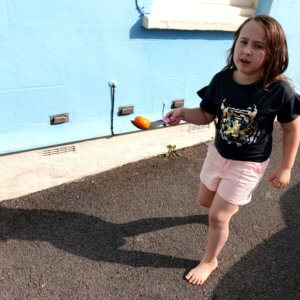 An egg and spoon race is a great way to challenge hand eye coordination while multi-tasking. If your child struggles with keeping the ball on the spoon, try with a soft toy on a wooden spoon.
An egg and spoon race is a great way to challenge hand eye coordination while multi-tasking. If your child struggles with keeping the ball on the spoon, try with a soft toy on a wooden spoon.The child must get from A to B without the ball falling of their spoon.
Progress this by putting obstacles in the way. Firstly just to walk around, then try to step over objects.
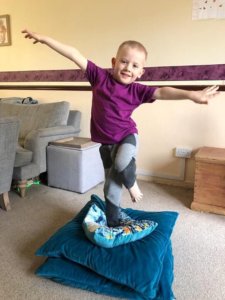 Using a beanbag or soft toy is great for this game.
Using a beanbag or soft toy is great for this game. Try to get from one end of the room to the other without it falling off your head.
Try carrying the beanbag when pretending to be a different animal or carrying it on different body parts.
Stand 2 children of similar sizes side by side their feet next to each other. If there aren’t 2 children, try this with your child but remember to remove your shoes to reduce the risk of stepping painfully on their feet!
Tie a dressing gown cord around the 2 people’s ankles. Make it nice and tight to make this more comfortable. Hold each other close and try to walk.
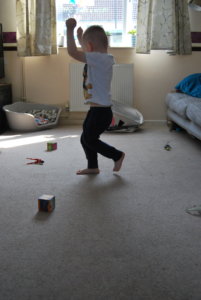 Set up several balls/ socks or beanbags about 1 meter apart with a bucket/ laundry basket at the end of the line (1m away).
Set up several balls/ socks or beanbags about 1 meter apart with a bucket/ laundry basket at the end of the line (1m away).Your child should start at the bucket end and run to pick up the first ball/ beanbag.
They should then run back to put it in the bucket.
Next run to the second ball and run back to put it in the bucket.
They should continue until all the beanbags are in the bucket.
You can set up a volleyball court with a piece of string between 2 walls in a corridor or between 2 chairs. The aim is to make the balloon/ ball touch the floor on your opponent’s side of the string. A corridor is great for this if your child has less accurate arm function as the walls keep the balloon in reach.
If your child has better hand/ eye coordination, put the 2 chairs with the string further apart so they have to run around more to retrieve the balloon.
Set up 10 bowling pins in a triangle shape – use loo roll inners or empty plastic bottles if you don’t have skittles.
Try to knock over all the skittles. See how many tries it takes to knock them down.
Get further away from the skittles as your child improves.
This is a fabulous and fully inclusive sport similar to Bowls.
See our video which explains how to play the game.
Dribble a balloon around the house using a broom stick. You could set up an obstacle course with chairs and a goal at the end for a single child game.
You could adapt it by keeping the balloon/ ball up in the air while they make their way around the house towards the goal.
Make an obstacle course which your child needs to dribble around – depending on their skills, they could go around objects or furniture or even try to go over objects with the ball.
Try getting from one end of the house, up the stairs and onto a bed with the ball.
You could have stations along the way – for example – kick 5 times against the wall, do 3 keepy uppys, do 5 squats, turn around on the spot etc.
Use empty tissue boxes on your child’s feet to slide around the floor. Challenge them to spin or slide on 1 leg.
You could try using more tissue boxes on their hands to pretend to be an ice-skating bear.
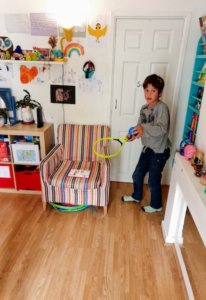 This great series, Tennis at Home created by the Lawn Tennis Association (LTA) provides simple ideas to practice your tennis skills in your back garden or in a room with a few meters of space.
This great series, Tennis at Home created by the Lawn Tennis Association (LTA) provides simple ideas to practice your tennis skills in your back garden or in a room with a few meters of space.
If you don’t have a tennis racket you can still try these games with a fly swatter, any other kind of bat, a roll of wrapping paper or a broom. You could use socks, a balloon or scrunched up paper instead of a ball.
This mini series gives some fun activities to do at home which are loosely rugby focused. You don’t need a rugby ball and most of their activities use things you can find around the house. Some are indoor, some are outdoor.
#TogetherActive Rugby Skills Episode 1
#TogetherActive Rugby Skills Episode 2 (Part One)
This video gives some lovely and very challenging ideas of what to do with a ball to improve your ball handling skills at home.







